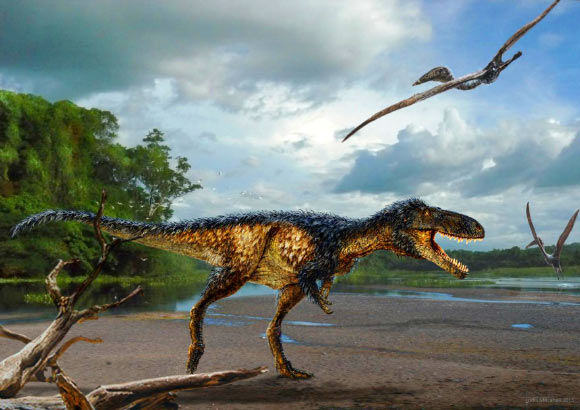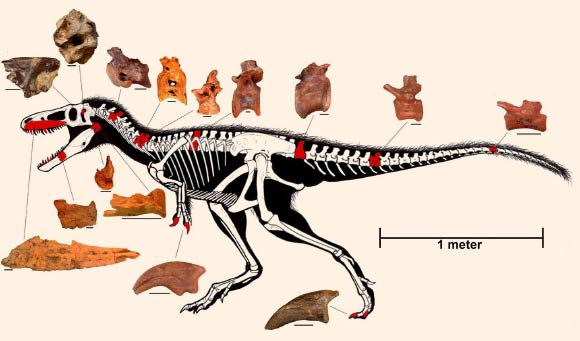A new dinosaur cousin of T. rex – named Timurlengia euotica — has been found in the Kyzylkum Desert, northern Uzbekistan.

A reconstruction of Timurlengia euotica, named for the charismatic Central Asian ruler Tamerlane, shows the species’ long, slender legs, large head and teeth built sharp like a steak knife. Image credit: Todd Marshall.
Timurlengia euotica lived during the Cretaceous period, approximately 90 million years ago, according to an international team of paleontologists led by Dr. Steve Brusatte from the University of Edinburgh, UK.
This species fills a 20 million year gap in the fossil record of tyrannosaurs — the iconic group of dinosaurian carnivores that includes T. rex and Albertosaurus, and provides key insights into how the group evolved.
“Timurlengia euotica’s skull was much smaller than that of T. rex, indicating that it did not grow to the same enormous size,” Dr. Brusatte and his colleagues said.
“However, key features of its skull reveal that its brain and senses were already highly developed.”
The new species was about the size of a horse, and could weigh up to 250 kg. It had long legs and a skull studded with sharp teeth, and was likely a fast runner.
“Timurlengia euotica was a nimble pursuit hunter with slender, blade-like teeth suitable for slicing through meat,” said team member Dr. Hans Sues, from the Smithsonian’s National Museum of Natural History.
“It probably preyed on the various large plant-eaters, especially early duck-billed dinosaurs, which shared its world.”
“Clues from the life of Timurlengia euotica allow us to fill in gaps and better understand the life and evolution of other related dinosaurs, like T. rex.”

In this reconstruction of Timurlengia euotica, the fossils are mapped out with locations on the animal. Image credit: Stephen L. Brusatte et al., doi: 10.1073/pnas.1600140113.
According to the team, the first tyrannosaurs lived during the Jurassic period, around 170 million years ago, and were only slightly larger than a human.
However, by the Late Cretaceous period — around 100 million years later — tyrannosaurs had evolved into animals like T. rex.
The small size of Timurlengia euotica some 80 million years after tyrannosaurs first appeared in the fossil record indicates that the huge size developed only toward the end of the group’s long evolutionary history.
“The ancestors of T. rex would have looked a whole lot like Timurlengia euotica, a horse-sized hunter with a big brain and keen hearing that would put us to shame,” Dr. Brusatte said.
“Only after these ancestral tyrannosaurs evolved their clever brains and sharp senses did they grow into the colossal sizes of T. rex.”
“Tyrannosaurs had to get smart before they got big,” he added.
“Central Asia was the place where many of the familiar groups of Cretaceous dinosaurs had their roots. The discoveries from the Kyzylkum Desert of Uzbekistan are now helping us to trace the early history of these animals, many of which later flourished in our own backyard in North America,” Dr. Sues said.
Timurlengia euotica is described in a paper published in the Proceedings of the National Academy of Sciences.
_____
Stephen L. Brusatte et al. New tyrannosaur from the mid-Cretaceous of Uzbekistan clarifies evolution of giant body sizes and advanced senses in tyrant dinosaurs. PNAS, published online March 14, 2016; doi: 10.1073/pnas.1600140113







